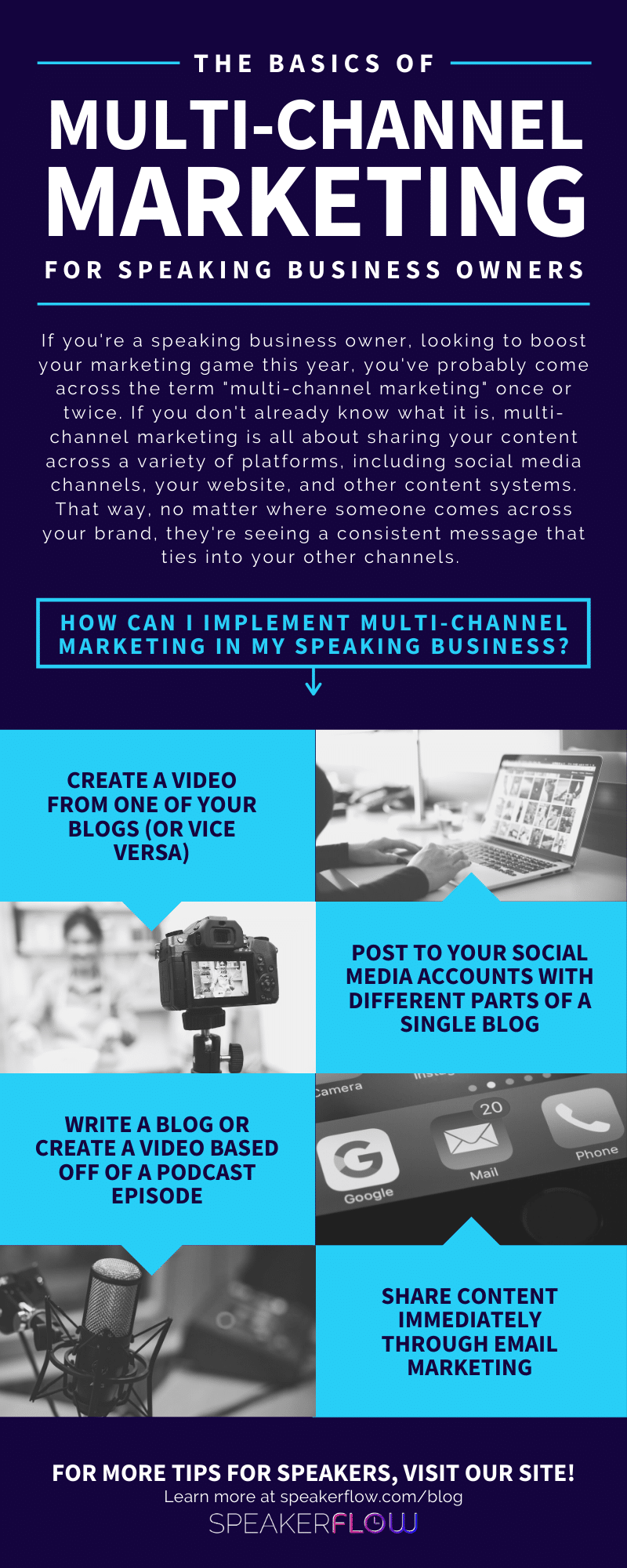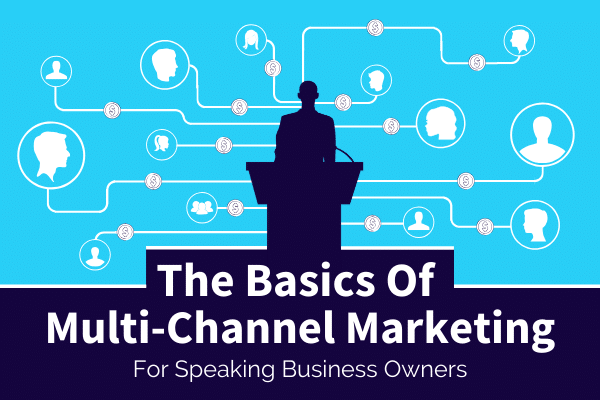It’s no secret that, regardless of your focus industry, the more attention you can bring to your business, the more revenue you’re likely to make. At its core, attracting this attention is what marketing is all about. In the speaking industry specifically, this includes social media posts, online webinars, advertising, and other digital content, such as blogs. However, in recent years, the number of avenues for leads to find your business has dramatically expanded. Where print advertising may have been big in the past, people can now find you through Facebook, Google Ads, or countless other digital platforms. That’s why multi-channel marketing – approaching leads from multiple sources – is more important now than ever.
Here, we’ll break down the basics of multi-channel marketing for speaking business owners, including what it is, why it matters, and how it can set you apart from your competitors. We’ll also walk through a few examples of multi-channel marketing. That way, even if you’re new to marketing altogether, you’ll know where to start. Below are the primary questions and topics we’ll cover:
What does “multi-channel marketing” mean?
Before we dive into the nuts and bolts of multi-channel marketing, let’s start at the beginning. What does ‘multi-channel marketing’ mean? By definition, multi-channel marketing is “the ability to interact with potential customers on various platforms”. These platforms include social media accounts, digital or print advertisements, or your website. Basically, taking a multi-channel approach in your marketing efforts means being active on many different platforms, both in terms of publishing new content and interacting with followers on these platforms.
Ultimately, the goal of multi-channel marketing is to increase the likelihood of a lead coming in contact with your brand. This not only demonstrates your skills, as a marketer and suggests your success as a business owner (i.e. makes you look like a large business, even if you’re a solopreneur). It also, because of this, makes leads or followers more likely to engage with you or your team and purchase your goods or services. In short, although it’s complex, implementing multi-channel marketing measures is a win for you and your clients, new or old.
What is the difference between “omni-” and “multi-channel marketing”?

The other common option, besides multi-channel marketing, is omnichannel marketing. By contrast, omnichannel marketing is “using digital and/or traditional marketing channels to send a relevant message to a brand’s customers regardless of the customer engaging with the brand, nor the channels used to engage”. In other words, omnichannel marketing uses marketing channels to create a seamless and personal experience for your leads and customers. This helps the lead or customer feel as though they are receiving personalized treatment.
To put it simply, omnichannel marketing takes a customer-centric approach. All in all, with omnichannel marketing, your goal is to provide content as customized as possible. That way, the potential client has something relevant in front of them no matter where they are in your sales funnel. On the other hand, with multi-channel marketing, your brand and message is the center of your approach. While the potential client is important (this is always the case), your main goals with multi-channel marketing are to (a) provide them with content that engages them and shows your expertise and (b) consistently share the same content across platforms. That way, no matter which platform a lead prefers, they’re likely to cross paths with your brand.
Ideally, in a perfect marketing strategy, both omnichannel and multi-channel marketing play a role in customer engagement. However, because of the complexity of strategizing and implementing an omnichannel marketing strategy, at SpeakerFlow we suggest focusing on a multi-channel approach first. This is especially true if you are new to marketing entirely.
Why is multi-channel marketing important for speakers?
That said, whether you have a hand in the marketing world already or you’re starting from scratch, multi-channel marketing is a tried and true part of a successful speaking business. In fact, many of the industries most well-known faces have been actively marketing in this way for years. Take speaker and author Simon Sinek, for example. On top of a modern, top-notch website, he and his team also regularly post on Facebook, Twitter, Instagram, and LinkedIn. On each of these channels, you’ll see a lot of the same content in addition to consistent interaction with followers that comment on his posts. He also shares this content, including blog posts, videos, and podcast appearances, across each channel, occasionally recycling a given blog or video when its focus is relevant again.
In the same way, multi-channel marketing isn’t just a way to share your ideas and your message. It’s a way to demonstrate that your message matters, you’re continually iterating on it as you learn and grow yourself, and it’s relevant to this day. This last piece, relevancy, is especially important now that sales and marketing so often take place digitally. In fact, with more and more business taking place online, the speaking industry is more fast-paced and competitive than it ever has been before. In light of this, learning to master multi-channel marketing is also more important than ever. After all, sharing your message and expertise means more attention. More attention means more new decision-makers who want you to speak for their upcoming event.
What are examples of multi-channel marketing?
So, we’ve covered the “what” and the “why” of multi-channel marketing. Now, let’s look at “how”. Like any marketing strategy, implementing a multi-channel marketing game plan involves a few steps. First, look for the platforms that are already gaining attention for your speaking business. Are you getting more likes on Facebook posts or Instagram posts? What content (blogs, videos, etc.) has gotten good reactions in the past? Identify these areas, then use them as starting points for your multi-channel marketing strategy.
Ultimately, multi-channel marketing involves sharing a single piece of content across all of your marketing platforms. Whether it’s blogs, videos, podcasts, or guest posts for other speakers or companies in your focus industry, the goal is to take content from one area and adapt it for another channel. Below are a few examples of how you can do this in your speaking business. 👍
Create a video from one of your blogs (or vice versa).
The first multi-channel marketing tactic is an easy one: create a video from an existing blog. In recent years, blogs have grown in importance parlty in that they show your credibility in your focus industry. However, blogs are also important from a technical standpoint. After all, the more detailed and well-written your blog, the more likely it is to rank at the beginning of a list of Google search results, bringing people to your website.
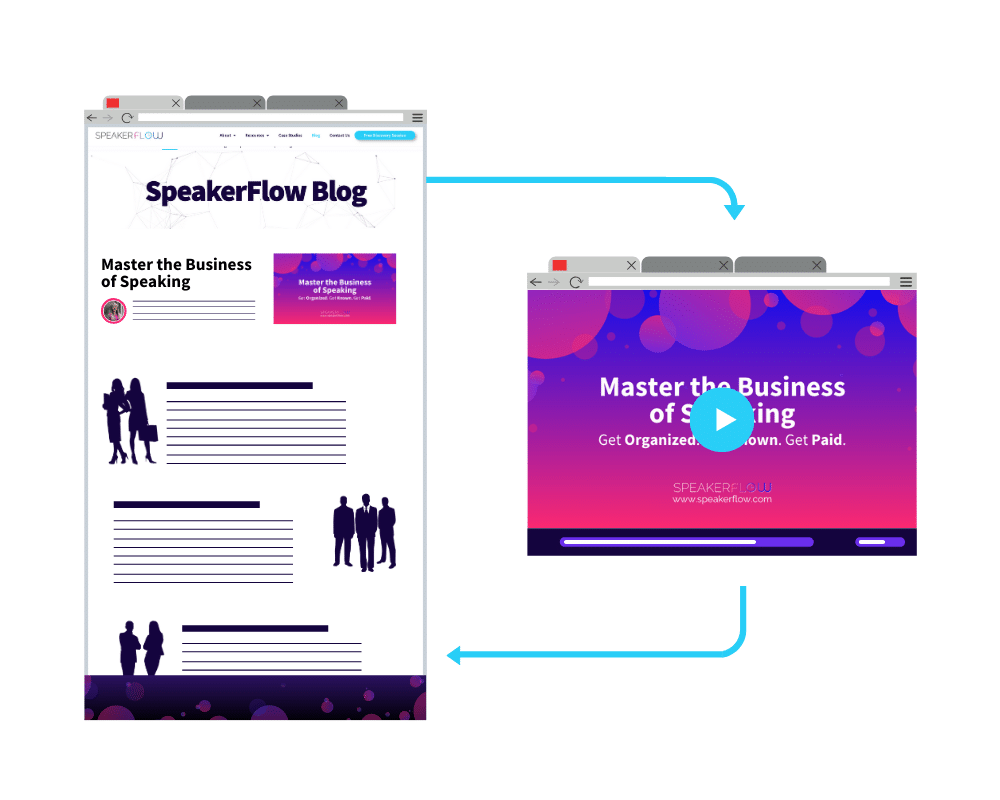
In total, there are dozens of factors that determine the value of a blog. However, in addition to written content, Google has also been prioritizing videos, both as parts of a blog and as standalone content. As a speaker, this gives you the prime opportunity to take what people in your focus industry are looking for, create a blog for it, then turn that blog into a video. From there, all that’s left to do is include a link for the video in the blog (and vice versa). Not so bad, right?
If you want your blog or video to rank well on Google, there are a few ways to hit the ground running:
- Use your keyword or phrase in the title of your blog or video. A few keywords we’ve used in the past, for example, are “speaking business” and “speaking industry”.
- Use your keyword repeatedly throughout your blog (including headers, if possible) and in the caption of your video.
- Before getting started, search your keyword in Google and click on the first result that appears. Your goal is to have a longer blog with more impactful content (images, videos, etc.) and more use of the keyword.
Keep in mind these are just the basics. For more information about crafting a well-written blog, check out our 30-Point Blog Checklist on our Resources page.
Post to your social media accounts with different parts of a single blog.
Another way to make use of existing content, including blogs, is to turn it into social media posts. From a blog post to an appearance on another business’s podcast, sharing your progress and insights with your social followers is a great way to showcase your experience and knowledge. Additionally, keeping your social profiles regularly updated, as you create or recycle content, shows your dedication to your business. Plus, it shows your dedication to your followers! Fundamentally, we’re all wired for connection and social interaction, so being social is an easy way to gain long term fans and loyal followers.
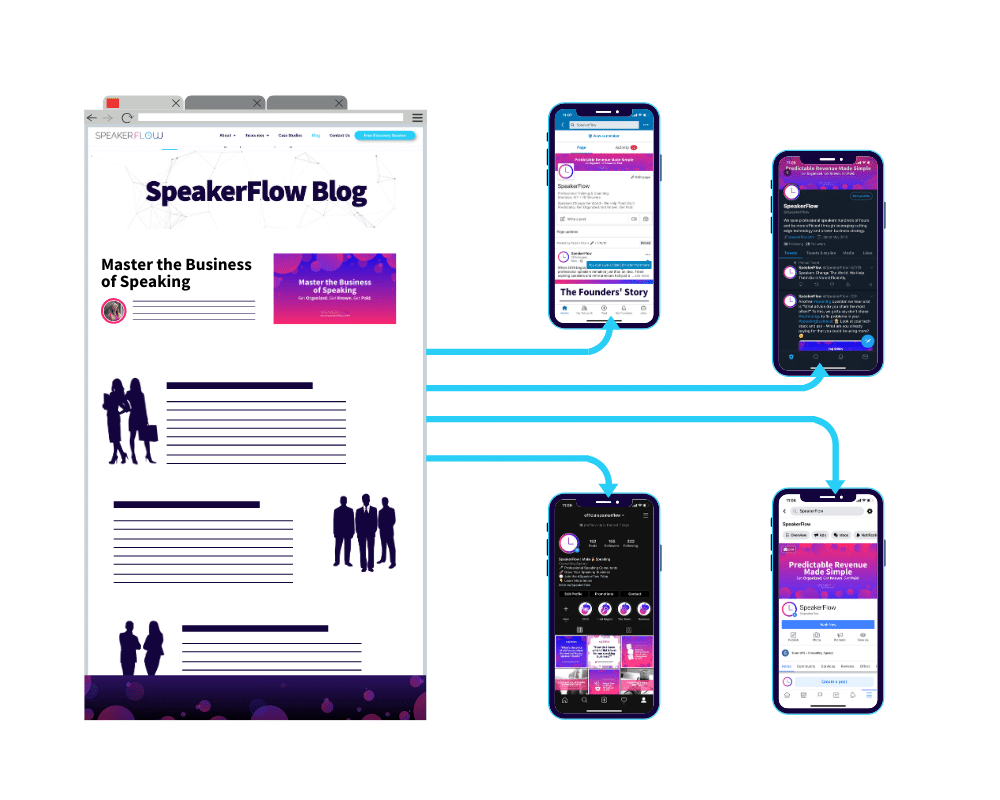
For example, if you look at SpeakerFlow’s Facebook, Twitter, Instagram, or LinkedIn pages, you can see a regular pattern of sharing our blogs, new and old. Additionally, on occasion, we’ve also broken up larger blogs into smaller pieces. This allows for a series of social posts, all of which link back to the same large blog and are much more digestible than the blog in its entirety. Because of this consistency in posting (and our candid replies to followers’ comments), our follower count and engagement has only increased since we launched in May 2019.
In the same way, look at the content you already have and see if you can break it down into multiple social posts. Below are a few examples to kickstart your creativity:
- Share a video on social media and link back to the related blog on your website.
- Create a quick summary video of a past, longer speech you gave and share it with the link to the full event recording.
- Break one of your podcast recordings into a series of social posts, with each one focusing on one tip from the episode. Then, link back to the full episode in each social post.
Write a blog or create a video based off of a podcast episode.
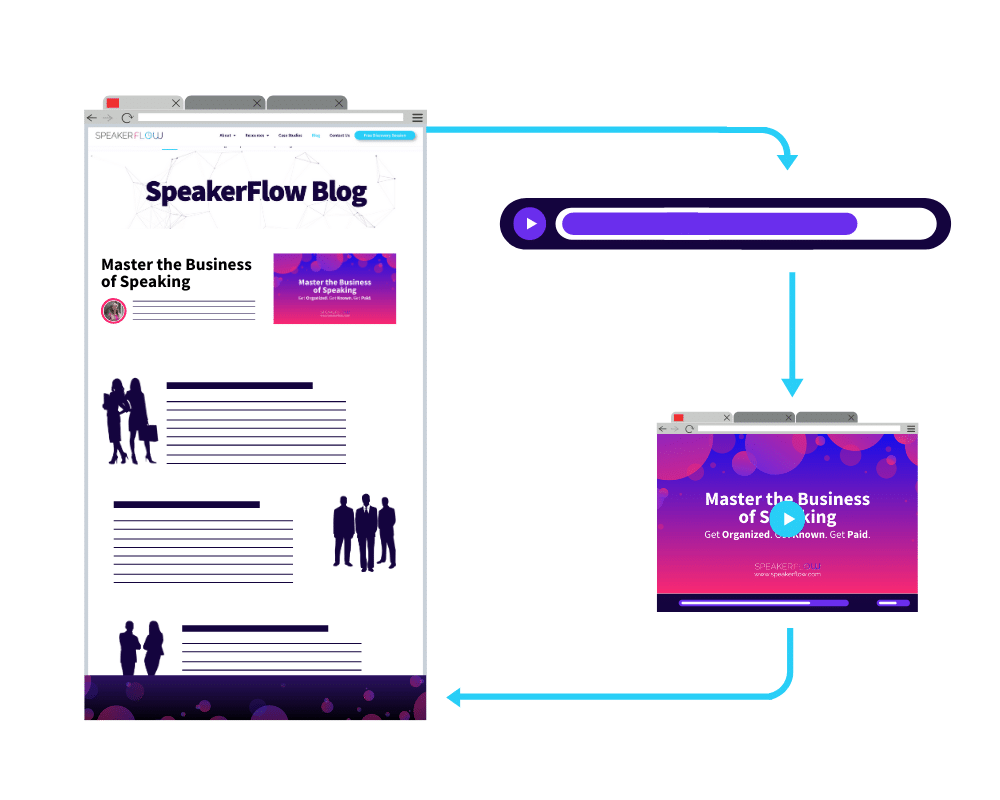
Speaking of podcasts, the third multi-channel marketing tactic in our list is audio content. Recently, the number of speaking businesses that host podcasts has exploded. Although the idea of sharing information through audio isn’t a new concept, the recent accessibility of podcasts not only allows listeners to choose exactly what they listen to. It also allows them to quickly and easily share their preferences with others without the hassle of trying to find the audio online, as you would for audio through a radio station.
There’s also the convenience factor. Unlike reading a blog or watching a video, listening to a podcast can be done on or offline, usually for free. For everyone from stay-at-home parents to commuters to office workers, this means they can listen anytime and anywhere. For you, as the podcast creator, this means a much wider and more diverse audience than you would get from a single content avenue, like a blog. In light of this, if you have a podcast already, great! You’re well ahead of the game. If you don’t, below are a few tips to a good podcast:
- Make your podcast available for free. It should act as a free offering that hooks your audience, so they see the value in your paid offerings.
- Record podcasts about videos you’ve already made or blogs you’ve already written. Then, link the three to each other and share the link to one of them on social media.
- Invite other major players in your focus industry to be guests on your podcast. Then, when you post your podcast on social media, tag them.
- Record video and audio when recording a new podcast episode (i.e. kill two birds with one stone) and use both as supplementary content for a blog of the same topic.
Share all of your content immediately through email marketing, not your newsletter.
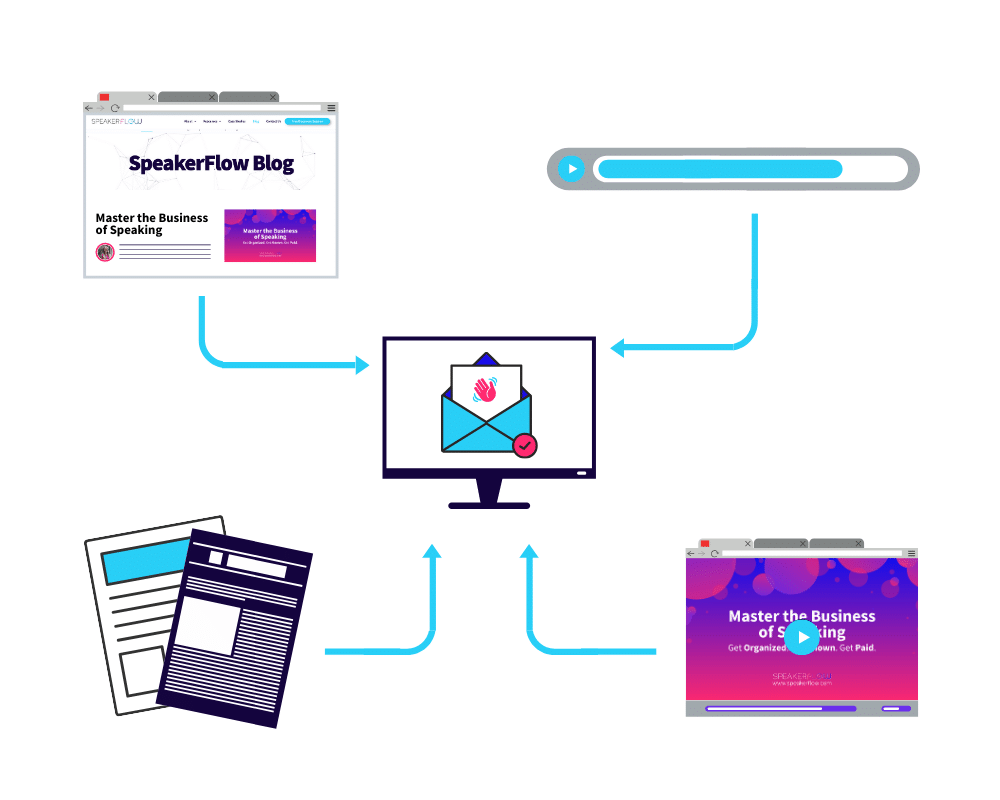
Lastly, as soon as you publish a new piece of content, make sure to share it with your subscribers! When they originally signed up for updates from your speaking business, this is exactly the information they were looking for. That means they’re already interested in your insights and are prime targets for your multi-channel marketing efforts. However, make sure that when you send out an update, it’s written specifically in regard to the content you’re sharing, and it’s as candid as possible. We’ve seen it time and time again with our clients: monthly newsletters are out, and custom update emails are in. Plus, the more you focus on being yourself and sharing what you know, the more comfortable your audience will feel, making them more likely to engage with you.
Ultimately, these four examples are just a few of the ways you can implement multi-channel marketing in your speaking business. For more examples of multi-channel marketing techniques and companies that are crushing the multi-channel marketing game, I highly recommend reading ClickZ’s “Four Brands Leading the Way in Multichannel Marketing”.
Additionally, for more information about marketing yourself as a speaker, check out our Ultimate Guide to Speaker Marketing or drop us a line! Whether you’re a new speaker or a seasoned expert, we’re here to help you get your marketing strategy on track. 😊
